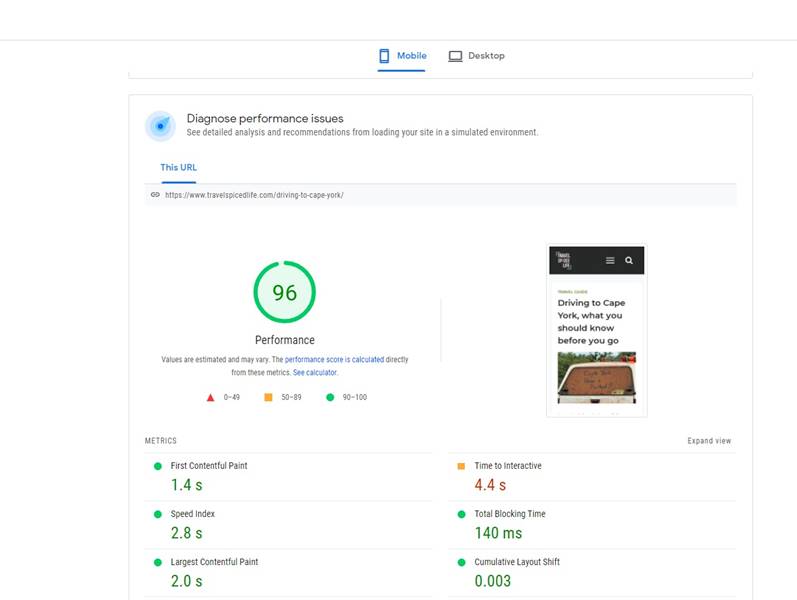Perform Technical SEO: Why is it Important for Your New Website
Launching a new website can be both exhilarating and daunting, as you strive to create a strong online presence and stand out in the digital landscape.
One crucial aspect that can make or break your website’s performance is Technical SEO. This often-overlooked component of search engine optimization can be the key to unlocking your website’s full potential.
By looking at the recent SEO stats from ahrefs, you can understand immediately that doing SEO on your website is critical to your overall success.
In this guide, you will learn:
Technical SEO Definition
Technical SEO refers to the process of optimizing your website’s infrastructure to improve its visibility, crawlability, and overall performance in search engine rankings.
It encompasses a wide range of factors, including site speed, mobile-friendliness, structured data, XML sitemaps, and URL structure.
By addressing these essential elements, Technical SEO ensures that search engines can efficiently crawl, index, and understand your website’s content, resulting in improved organic search rankings and a more user-friendly experience for your visitors.
In essence, Technical SEO lays the foundation for a successful online presence, paving the way for your website to thrive in an increasingly competitive digital landscape.
Significance of Technical SEO in Digital Marketing
Let’s explore some of the key reasons why Technical SEO is so important in digital marketing.
Enhanced User Experience
Some elements of SEO ensure that your website loads quickly displays optimally on various devices, and is easy to navigate.
When visitors can effortlessly access and consume your content, they are more likely to stay on your site longer, share your content, and become loyal customers.
Improved Organic Search Rankings
Search engines, such as Google, prioritize websites that provide a smooth user experience and adhere to their guidelines.
By implementing Technical SEO best practices, you’re not only making it easier for search engines to crawl and index your content, but you’re also sending positive signals that contribute to higher organic search rankings.

As a result, your website will attract more targeted traffic, which can lead to increased conversions and revenue.
Bolstered Credibility and Trust
Consistency is key to success!
A well-optimized website that performs consistently and flawlessly demonstrates professionalism and credibility to your visitors.
Technical SEO helps to establish trust by ensuring that your website is secure, accessible, and adheres to industry standards. This, in turn, can foster a positive brand image and encourage repeat visits and customer loyalty.
Long-term Cost-effectiveness
While Technical SEO might seem like an upfront investment, it ultimately saves you time and money in the long run.
By addressing technical issues from the outset, you can avoid potential penalties from search engines and prevent costly website redesigns or fixes down the road.
Additionally, a technically optimized website can lead to higher organic search rankings, reducing the need for extensive paid advertising campaigns.
Compatibility with Future Trends
As technology continues to advance, search engines will increasingly emphasize the importance of user experience and site performance in their algorithms.
By prioritizing Technical SEO now, you’re setting up your website for success in the long term, ensuring that it remains compatible with emerging trends and technologies.
In conclusion, Technical SEO is an integral component of digital marketing that cannot be overlooked.
Don’t let your website fall behind; use the power of SEO and watch your online presence flourish.
Difference Between Technical SEO and Off-Page SEO
Technical SEO is primarily concerned with optimizing your website’s infrastructure to enhance its visibility, crawlability, and overall performance in search engine rankings.
It deals with elements such as site speed, mobile-friendliness, structured data, XML sitemaps, and URL structure, all of which contribute to a seamless user experience and efficient crawling and indexing by search engines.
A typical technical, on-page SEO could be updating image alt tags, setting correct headers and page structure or creating XML Sitemap.
On the other hand, off-page SEO revolves around building your website’s authority, credibility, and online reputation by creating high-quality backlinks from other websites.
This can be achieved through various strategies, such as content marketing, social media marketing, influencer outreach, and guest blogging.
Off-page SEO focuses on generating buzz and earning external endorsements that signal to search engines that your website is valuable and trustworthy.
How Big an Impact Technical SEO Has on Your New Website
I mentioned already why technical SEO is important in digital marketing, but here I want to focus on three main things that impact your website’s future.
Strong Foundation
You can’t imagine how many websites on the internet don’t have SEO done from the word go. In our Brisbane SEO Agency, we have clients that have old websites but they have never done SEO.
My point here is that SEO is a must if you want to succeed in the future. It is always better to start doing it from the beginning.
Why?
Technical SEO sets the stage for all your other SEO efforts by ensuring that your website’s infrastructure is optimized for search engines.
It helps create a solid foundation upon which your on-page and off-page SEO strategies can thrive. A well-optimized website allows search engines to efficiently crawl, index, and understand your content, which is vital for achieving high organic search rankings.
Start Better Than Your Competitors
In today’s competitive digital environment, it’s crucial to find ways to differentiate your website from the competition.
By prioritizing technical SEO from the outset, you can ensure that your new website is better equipped to compete with established players in your niche.
A technically optimized website can help you stay ahead of emerging trends and technologies, giving you an advantage over competitors who may have overlooked the importance of Technical SEO.
I understand that website design and look and feel is important for business owners, but let’s now forget what is running behind the scene – it is your technical SEO.
Let’s say we have two new business websites that start today. Both have the same number of pages and posts. Which one will perform better with Google over time?
I think the answer is obvious.
Long-Term Success
Technical SEO is not a one-time effort but rather an ongoing process that contributes to your website’s long-term success.
By regularly monitoring and updating your technical SEO practices, you can ensure that your new website remains compliant with search engine guidelines and maintains optimal performance.
This not only helps to future-proof your website but also reduces the risk of penalties that can negatively impact your search rankings and online presence.
Essential Elements of Technical SEO for Your Website’s Success
Let’s list the main elements of technical SEO. This is not a full list though and rather the major components of SEO to get you interested in what is important.
#1 Website Speed Optimization
Website speed optimization is the process of enhancing your website’s load times to provide a faster and more seamless user experience.
A fast-loading website not only improves user satisfaction but also positively impacts search engine rankings, as site speed is a crucial ranking factor.
To optimize your website’s speed, consider implementing the following strategies:
- Compress images and files to reduce their size, using tools such as TinyPNG or Gzip.
- Use a content delivery network (CDN) to distribute your website’s files across multiple servers worldwide, ensuring faster loading times for users regardless of their location.
- Minify CSS, JavaScript, and HTML files to eliminate unnecessary characters and whitespace, streamlining your code and improving load times.
- Implement browser caching to store parts of your website locally on a user’s device, reducing the need to load the entire site on subsequent visits.
- Optimize your website’s code by removing render-blocking JavaScript and CSS, enabling your site to load and display content more quickly.
- Choose a reliable and high-performance web hosting provider to ensure optimal server response times.
Those sound a bit technical but don’t worry. You have two choices here.
- WordPress Plugins – Most of the above optimisation can be done with WordPress plugins like WP Rocket or Breeze (from Cloudways). Usually, you can do most of the configuration with free versions, but if you want to take it to the next level you can invest in a paid version.
- Hire SEO Agency – If you are not a technical person, you can seek help to get the basic setup done by a professional SEO.
The final part is the always verify your speed with Google Page Insights.

#2 Mobile Responsiveness
Achieving mobile responsiveness involves designing and developing your website to ensure that its layout, images, and other elements automatically adjust to fit the screen on which it’s being viewed.
This can be accomplished through the following steps:
- Use responsive web design principles, such as fluid grids and flexible images, to create a website layout that smoothly adapts to different screen sizes.
- Implement CSS media queries to apply different styles and formatting based on the device’s characteristics, such as screen resolution or orientation.
- Optimize images and content to ensure they load quickly and display correctly on mobile devices.
- Simplify navigation and ensure touch-friendly interface elements, making it easy for users to interact with your website on smaller screens.
- Regularly test your website’s mobile responsiveness using tools like Google’s Mobile-Friendly Test or BrowserStack, allowing you to identify and fix any issues that may arise.
Luckily most WordPress themes are mobile responsive so part of the job is already done for you.
#3 Make It Secure With SSL
Making your website secure with SSL should be as simple as clicking a few buttons to enable SSL.

Depending on the hosting provider SSL can be free or paid. Before choosing one make sure you don’t have to pay an additional fee to enable SSL.
#4 Well-Structured XML sitemap
A website sitemap is a structured outline or map of all the pages and content within a website.
It serves as a blueprint that helps search engines, like Google, easily discover, crawl, and index the pages on your site, ensuring they are accurately represented in search results.
Again, sitemaps are automatically generated when you use SEO plugins like RankMath.
What you only have to do is to take the URL and submit it to Google Search Console.
#5 Create a robots.txt file
A robots.txt file is a simple text file that provides instructions to search engine crawlers (also known as robots or bots) on how to interact with your website.
The primary purpose of the robots.txt file is to guide these crawlers on which pages or sections of your site they should or should not crawl and index, helping you control your website’s visibility in search results.
Again, you don’t have to create one. RankMath will do it for you automatically.
#6 Duplicate and Old Content
Duplicate and old content can have a negative impact on your website’s search engine rankings, user experience, and overall credibility.
Ensuring that your website is free from duplicate content and regularly updating or removing outdated information is crucial for maintaining a high-quality, relevant, and trustworthy online presence.
The above are the main elements of technical SEO.
For a comprehensive list visit our SEO Checklist.
How to Monitor and Analyse Technical SEO
Monitoring and analyzing your website’s technical SEO performance is crucial for identifying areas of improvement, optimizing your site’s search engine rankings, and maintaining a user-friendly experience.
By regularly evaluating your technical SEO, you can stay ahead of potential issues and make data-driven decisions that enhance your website’s overall performance.
Here are some key strategies for effectively monitoring and analyzing your technical SEO.
Utilize SEO Auditing Tools
SEO auditing tools play a vital role in assessing your website’s technical health, helping you identify issues that could negatively impact your search engine performance.
Tools like Google Search Console, SEMrush, Ahrefs, or Screaming Frog can provide insights into crawling errors, broken links, duplicate content, and other technical issues that may require your attention.
Monitor Site Speed and Performance
Site speed is a crucial ranking factor and has a direct impact on user experience.
Regularly monitoring your website’s speed and performance using tools like Google PageSpeed Insights, GTmetrix, or WebPageTest can help you identify bottlenecks, optimize load times, and ensure that your website is performing at its best across all devices.
Keep an Eye on Mobile Responsiveness
With the growing number of users accessing the internet via mobile devices, it’s essential to ensure that your website is mobile-friendly.
Use tools like Google’s Mobile-Friendly Test or BrowserStack to regularly evaluate your website’s mobile responsiveness and address any issues that may arise, such as poor layout, slow load times, or inaccessible content.
Check Your Website’s Indexing Status
Ensuring that your website’s content is properly indexed by search engines is critical for visibility in search results.
Regularly monitor your website’s indexing status using Google Search Console or other SEO tools to identify potential issues, such as blocked URLs, crawl errors, or sitemap problems, that may hinder your website’s search engine performance.
Analyze Your Website’s Link Profile
A healthy backlink profile is crucial for SEO success, as it signals to search engines that your website is a reputable and authoritative source of information.
Use tools like Ahrefs, SEMrush, Moz, or Majestic to regularly analyze your website’s link profile, identify broken or low-quality links, and uncover opportunities for acquiring new high-quality backlinks.
Stay Up to Date
The world of SEO is constantly evolving, and staying informed about best practices and algorithm updates is key to maintaining a well-optimized website.
Regularly read industry blogs, attend webinars, or participate in SEO forums to stay up-to-date on the latest trends and strategies, ensuring that your technical SEO efforts align with current search engine guidelines and expectations.
Perform Technical SEO for New Website – Final Word
In conclusion, performing technical SEO for your new website is a critical aspect of ensuring its success in the competitive online environment.
By addressing key elements such as site speed, mobile responsiveness, indexing, and link profile, you can build a strong foundation for your website that not only improves search engine rankings but also delivers an exceptional user experience.
Regularly monitoring and analyzing your technical SEO performance enables you to stay ahead of potential issues and make data-driven decisions that contribute to your website’s growth and long-term success.
Remember, technical SEO is an ongoing process that requires consistent attention and optimization, so stay informed about industry best practices and continuously refine your strategy to maintain a high-performing, search engine-friendly website.



